Phylum Rotifera — Wheel Animals
Characteristics
- Very small, most <1 mm.
- Varied, complex shapes
- Anterior end has paired coronas lined with cilia
- Many forms are sessile, attach via posterior foot
- Mostly fresh water; a few are parasitic
- Most are parthenogenic
- Without Acanthocephalans, the group is paraphyletic
- Clade that includes rotifers and acanthocephalans sometimes called Syndermata
|
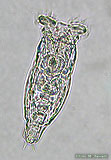
Fresh-water Rotifer, Philodina sp.; 100x
See also labeled photo.
|
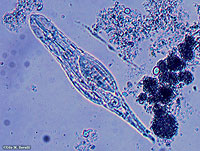
Fresh-water Rotifer, Adineta sp.
|
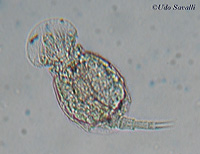
Fresh-water Rotifer, Squatinella sp.; collected Toleson, AZ
|
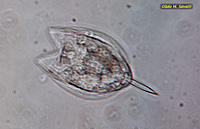
Fresh-water Rotifer, Monostyla sp.?; 100x
|
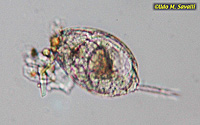
Fresh-water Rotifer, Euchlanis sp.; 200x
|
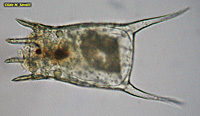
Fresh-water Rotifer, Keratella sp.; Phoenix, AZ
|
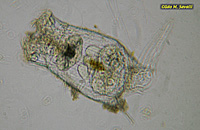
Fresh-water Rotifer, Brachionus sp.; Rio Salado, AZ; 200x
|
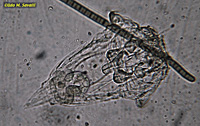
Fresh-water Rotifer, Synchaeta sp.; Tolleson, AZ; 200x
|
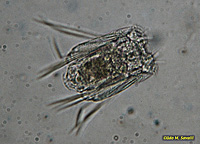
Fresh-water Rotifer, Polyarthra sp.; Rio Salado, AZ; 200x
|
Brachionus rotifer with egg next to it (bright field, 20x objective lens)
|
Brachionus rotifer feeding (bright field, 20x objective lens)
|
|
Acanthocephala — Spiny-headed Worms
Characteristics
- Body cylindrical, usually with rings of small spines
- Fluid-filled proboscis with hooks and spines
- Lack gut; reduction of most organs
- Pseudocoelom filled with large gonads
- Intestinal parasites of vertebrates
- Derived from within rotifer group
- Formerly considered a separate phylum, but now is generally treated as a Class of rotifers
|

Acanthocephalan, stained whole mount
|

Spiny-headed worm, Neoechinorhynchus sp., preserved specimen
|
|
Phylum Chaetognatha — Arrow Worms
Characteristics
- Elongate, streamlined bodies
- Lateral & caudal fins supported by rays
- Mouth surrounded by grasping spines
- Complete gut
- Longitudinal but not circular muscles
- Pelagic marine predators
|

Sagitta sp., stained whole mount
See also labeled photo.
|

Arrow worm, Sagitta sp., preserved specimen
|
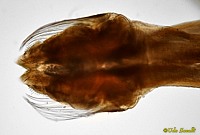
Sagitta sp., closeup of head; preserved specimen
|
|













